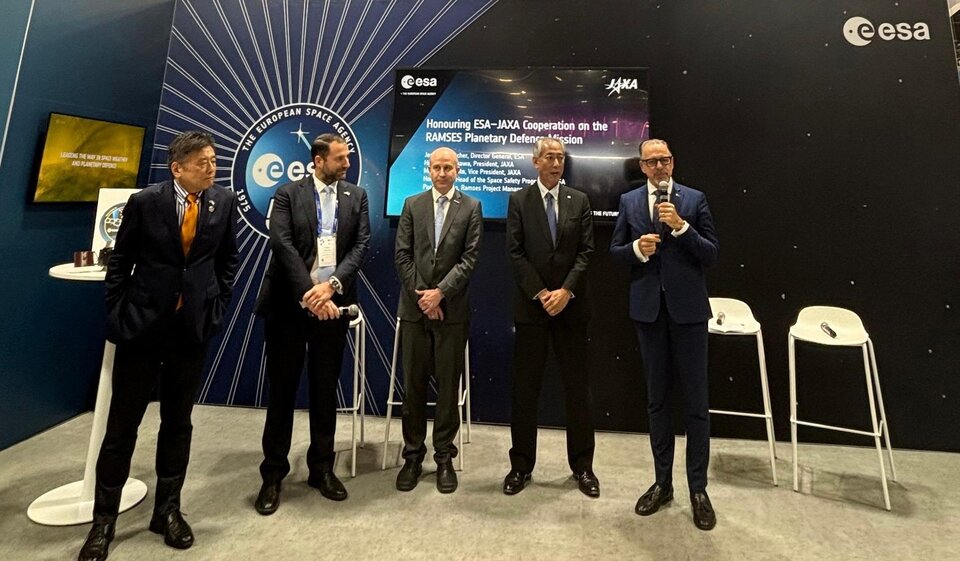SYDNEY — Europe is deepening cooperation with South Korea and Japan as it looks to expand its international cooperation activities on Earth and in space.
The European Space Agency (ESA) and the Korea AeroSpace Administration (KASA) signed a memorandum of understanding (MoU) for enhanced cooperation here at the 76th International Astronautical Congress (IAC) here in Sydney on Wednesday (Oct. 1).
The agreement will allow the agencies to use each others’ ground stations for telemetry, tracking and command functions. The MoU also covers future areas of cooperation including space science, exploration, human spaceflight, in-space infrastructure and beyond. There is also an intention to work together on space weather.
You may like
“This is an important moment for Europe and Korea, opening up great opportunities for our space interests, and strengthening existing systems through cooperation,” ESA Director General Josef Aschbacher said in a statement. “In ESA, we are excited to learn from our colleagues in KASA, and to share our experience to reach complementary goals.”
“KASA’s objectives include enhancing global space cooperation;” said Youngbin Yoon, KASA’s administrator. “Today, we have taken an important step, and we look forward to our shared journey in cooperation in space activities for peaceful purposes.”

ESA and JAXA honor cooperation on the Ramses mission at IAC 2025. (Image credit: ESA)
Support from ESA’s Estrack global ground station network could help facilitate South Korea’s lunar ambitions, with ESA having played a similar role during the development of China’s Chang’e lunar program.
South Korea’s moon program already includes the Danuri spacecraft, which is in lunar orbit, capturing stunning images of the moon. But the country is now building toward a robotic lunar lander to be launched by a homegrown rocket, with a grander vision of establishing a moon base by 2045 as part of a long-term exploration road map released by KASA in August. Earlier this year, the agency began converting an abandoned mine to a testing ground for lunar exploration.
The developments come as ESA earlier this year began considering diversifying and deepening global partnerships in the wake of uncertainty over the NASA budget and the future of cooperative programs. ESA also held discussions with India on deepening their cooperation at IAC in Sydney.
India is a strategic partner with enormous capacity and is precisely the type of nation that @esa and its Member States want as a partner. Today, with @isro, we discussed ways of deepening collaboration in three main areas: Exploration, Earth Observation, and Operations. pic.twitter.com/A5cVzsm88ROctober 1, 2025
Asteroid rideshare with Japan
A day earlier, ESA’s Aschbacher celebrated recent milestones in cooperation with the Japan Aerospace Exploration Agency (JAXA) with agency head Hiroshi Yamakawa. Both men addressed IAC at a Heads of Agencies event on Sept. 29.
Aschbacher celebrated a recent rideshare agreement that will see ESA’s Ramses spacecraft and Japan’s Destiny+ mission launch together on a Japanese H3 rocket to study the former doomsday asteroid Apophis ahead of its 2029 close encounter with Earth.
“Ramses is not only a scientifically exciting mission and a symbol of two partnerships between Japan and ESA, but it also is a good example of quick project development and implementation,” Aschbacher said.
The main objective for Destiny+ is to study the asteroid 3200 Phaethon, the parent body of the Geminid meteor shower. Launch delays have, however, provided the opportunity for the spacecraft to first visit Apophis, and for a serendipitous rideshare for Ramses.
ESA still needs to get a final positive decision on funding for the mission at a key ministerial meeting of member states in November, but the Ramses spacecraft is already advancing along its development path. Aschbacher also highlighted recent cooperation with JAXA on the EarthCare mission, which launched last year.


AloJapan.com